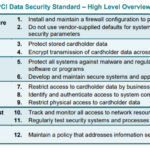Embracing the obligation to ensure sustained PCI-DSS compliance within your company’s infrastructure is a critical challenge you need to confront. The article, “Strategies for Maintaining PCI-DSS Compliance in a Company Over Time,” presents an insightful exploration of the various approaches you can implement to ensure ongoing adherence to these essential standards. Not only will this equip you with effective strategies to uphold regulatory compliance, but it will also empower your organization with the security measures vital in today’s digital landscape. As you progress through this engaging reading, anticipate acquiring profound knowledge that could potentially uplift the resilience of your company’s security framework.
Understanding PCI-DSS Compliance
Definition of PCI-DSS compliance
PCI-DSS stands for Payment Card Industry Data Security Standard. It is a set of requirements designed to ensure that ALL companies that process, store, or transmit credit card information maintain a secure environment. When a corporation follows these rules, it is said to be PCI-DSS compliant.
Importance of PCI-DSS compliance in a company
Compliance with PCI-DSS is essential for any company that deals with cardholder data. This not only inspires customer trust but also helps to safeguard the company against data breaches and theft of customer information. Being compliant also helps companies avoid penalties that can be imposed due to non-compliance, such as fines, extra charges, increased transaction fees, and even the possibility of losing the ability to process credit card payments.
Different levels of PCI-DSS compliance
PCI-DSS compliance is categorized into four levels, depending on the volume of transactions that a company handles annually. Level 1 is for organizations that process over 6 million card transactions per year. Level 2 is for entities that process 1 to 6 million transactions annually. Level 3 covers entities handling 20,000 to 1 million transactions per year, and Level 4 is for businesses that process fewer than 20,000 transactions annually.
Establishing PCI-DSS Compliance
Identifying the applicable PCI-DSS requirements
The first step in establishing PCI-DSS compliance is to identify which requirements apply to your business. These may relate to securing your network, protecting stored cardholder data, maintaining a vulnerability management program, implementing access control measures, regular network testing, and maintaining an information security policy.
Developing a strategy for achieving initial compliance
Once you’ve identified your applicable requirements, the next step is to develop a strategic plan to achieve compliance. This may involve evaluating your existing infrastructure, designing system enhancements, and developing risk management processes.
Implementing controls and technological solutions
Achieving PCI-DSS compliance requires implementing various controls and technological solutions. These can include firewall installations, encryption of stored data, use of secure systems and applications, restricting cardholder data access, and regular testing of security systems.
Developing a PCI-DSS Compliance Program
Establishing a compliance team
To ensure that your organization consistently meets PCI-DSS standards, it’s crucial to establish a dedicated compliance team. This team will be responsible for the continual monitoring of your security measures, the updating of compliance protocols, and training other employees on PCI-DSS compliance.
Defining responsibility for compliance
Clear lines of responsibility are key to effective PCI-DSS compliance. Each member of the compliance team should have clear roles and know exactly what they are responsible for in meeting and maintaining compliance.
Creating compliance policies and procedures
A crucial part of a PCI-DSS compliance program is the creation of written policies and procedures. These should detail how your organization will meet each PCI-DSS requirement, and should cover every relevant aspect of your company’s operations.
Continuous Documentation
Benefits of continuous documentation
Keeping continuous and comprehensive documentation is an integral part of PCI-DSS compliance. The benefits of maintaining this documentation include providing evidence of compliance for audits, ensuring crucial information is effectively communicated across the company, identifying gaps or potential issues, and making it easier to update procedures as necessary.
Use of tools to enable continuous documentation
Leveraging the right tools can significantly simplify continuous documentation. These tools can automate the collection, storage, and analysis of compliance data, and may also generate reports for audits.
Strategies to ensure validity and accuracy of documentation
To ensure the validity and accuracy of your PCI-DSS documentation, it’s important to use reliable data sources, to regularly review and update the information, and to train staff on proper documentation procedures.
Regularly Monitoring and Testing Security Systems
Importance of routine risk assessments
No security system is foolproof. Regular risk assessments are therefore vital to anticipate potential vulnerabilities and make necessary improvements. This proactive approach is key to maintaining PCI-DSS compliance.
Techniques for testing security systems
Testing security systems can involve identifying potential system vulnerabilities, implementing internal and external penetration tests, and conducting network segmentation checks. Regularly testing your systems also ensures your defenses remain effective against evolving security threats.
Handling detected vulnerabilities
In the event that a security vulnerability is detected, swift action is required. The vulnerability should be assessed, and corrective measures should be put in place to mitigate any potential risk.
Employee Training and Awareness
Key elements of PCI-DSS awareness training
To ensure compliance, it’s pivotal that all employees are familiar with PCI-DSS requirements and understand the role they play in compliance. This can be achieved through a comprehensive training program that includes topics such as secure data handling, common security threats, and the consequences of non-compliance.
Strategies for ongoing employee training
To ensure your training program is effective and that employees remain knowledgeable about PCI-DSS, it is important to offer regular training sessions, provide accessible training materials, and test employee understanding of the subject matter.
Necessity of maintaining an open dialogue about compliance with employees
Maintaining an open dialogue about compliance encourages employees to actively engage in the company’s security efforts. Compliance should not be seen as a one-time achievement but a constant process that involves employees at all levels.
External and Internal Audits
Reasons to conduct both internal and external audits
Both internal and external audits play a crucial role in maintaining PCI-DSS compliance. While internal audits allow for regular, detailed reviews of your compliance status, external audits provide an objective assessment of your company’s adherence to PCI-DSS standards.
Best practices for internal auditing
For an effective internal audit, establish a regular audit schedule, define scope clearly, ensure auditors are independent and unbiased, and use the results to refine your compliance processes.
Preparing for an external compliance audit
To prepare for an external audit, ensure all necessary documentation is up-to-date and readily available, educate staff on the audit process, and implement any corrective measures identified during internal audits.
Maintaining a Secure Network Environment
Techniques to safeguard cardholder data
Protecting cardholder data is at the heart of PCI-DSS compliance. Techniques to accomplish this include encryption, tokenization, data masking, secure disposal of outdated data, and implementing firewalls.
Strategies to prevent and detect intrusions
Preventing and detecting intrusions requires a layered security approach. This includes intrusion detection and prevention systems, maintaining up-to-date antivirus software, and frequently analyzing system logs for irregular activity.
Maintaining an incident response plan
In the event of a security incident, immediate action is needed. A comprehensive incident response plan ensures that your company can react quickly and effectively to minimize damage and maintain trust with your customers.
Involvement of Upper Management
Importance of support from upper management
Sustained compliance with PCI-DSS requires a top-down approach, with full support from upper management. Their commitment sets the tone for the entire organization, reinforces the importance of compliance, and provides the resources needed to implement and maintain the necessary security controls.
Inclusion of PCI-DSS compliance in strategic planning
PCI-DSS compliance should be an integral part of your company’s strategic planning. In doing so, you ensure that compliance measures keep pace with growth, change, or shifts in your own business or the wider industry.
Engagement of upper management in compliance program
Upper management should not only support but also actively participate in the compliance program. This could involve taking part in strategy meetings, reviewing audit results, and ensuring that the compliance program is adequately funded.
Vendor and Third-party Compliance
Managing third-party risks
Third-party service providers and vendors can present security risks to your data. It’s therefore crucial to manage these risks properly, assess their security measures, and ensure they’re also PCI-DSS compliant.
Ensuring vendor compliance with PCI-DSS requirements
To ensure that vendors meet PCI-DSS requirements, it’s necessary to include compliance in your contracts, perform regular audits, and establish secure mechanisms for data exchange.
Steps to take when a vendor fails to meet compliance standards
In the event of a vendor failing to meet PCI-DSS compliance, immediate action should be taken. This might include requiring the vendor to address deficiencies, considering alternative vendors, or even terminating the relationship if needed.











[…] this arduous compliance across multiple locations, the challenge intensifies exponentially. “Overcoming Challenges in Maintaining PCI-DSS Compliance across Multiple Locations” provides you with practical insights and strategies to streamline […]